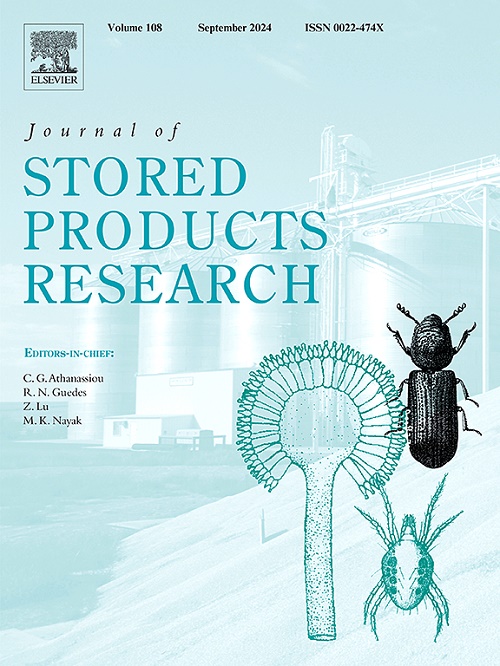Insecticidal potential of diatomaceous earth against Callosobruchus maculatus (Coleoptera: Chrysomelidae) infesting stored cowpea, Bambara groundnut and soybean in the Sudano-Guinean climatic conditions of Cameroon
IF 2.7
2区 农林科学
Q1 ENTOMOLOGY
引用次数: 0
Abstract
Diatomaceous earth (DE), derived from fossilized diatoms, serves as an effective alternative to synthetic insecticides for grain protection. This study assessed two DE products, Silico-Sec® and Fossil Shield®, against Callosobruchus maculatus in cowpea, Bambara groundnut, and soybean stored in Cameroon's Sudano-Guinean agro-ecological zone. Four DE doses (0.5, 1, 1.5, and 2 g/kg grain) were evaluated, along with malathion at 0.5 g/kg. Mortality was recorded over six days, and oviposition and F1 progeny production were measured at day seven and at F1 emergence, respectively. Both DE formulations exhibited dose-dependent mortality, with Silico-Sec® achieving 96.5% mortality in cowpea within three days (LD50 = 0.54 g/kg) and Fossil Shield® reaching it in four days (LD50 = 0.33 g/kg) at 2 g/kg. High efficacy was similarly noted for soybean and Bambara groundnut, with both DEs surpassing 95% mortality within 3 day at the highest dose. Furthermore, Silico-Sec® and malathion significantly reduced oviposition on cowpea by 98%, while Fossil Shield® achieved a 71% reduction; analogous trends were observed for F1 progeny inhibition. Silico-Sec® demonstrated efficacy comparable to malathion across all parameters, underscoring its potential as a sustainable option in integrated pest management against C. maculatus in this region of Cameroon.

求助全文
约1分钟内获得全文
求助全文
来源期刊
CiteScore
5.70
自引率
18.50%
发文量
112
审稿时长
45 days
期刊介绍:
The Journal of Stored Products Research provides an international medium for the publication of both reviews and original results from laboratory and field studies on the preservation and safety of stored products, notably food stocks, covering storage-related problems from the producer through the supply chain to the consumer. Stored products are characterised by having relatively low moisture content and include raw and semi-processed foods, animal feedstuffs, and a range of other durable items, including materials such as clothing or museum artefacts.

 求助内容:
求助内容: 应助结果提醒方式:
应助结果提醒方式:


